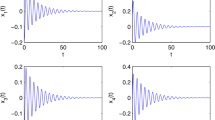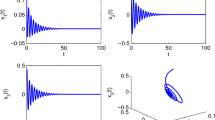Abstract
In this paper, we delve into the Hopf bifurcation of a novel high-dimensional delayed fractional neural network model with bicyclic structure sharing a node. Under some mild assumptions, the developed model is equivalently transformed into a system with two delays representing, respectively, the sum of delays in each ring. By applying the formula of Coates’s flow graph, we first derive the associated characteristic equation of the transformed system. Then, picking one delay as a control parameter and regarding the other one as a constant in its stable interval, we establish the respective critical value of each delay for the occurrence of Hopf bifurcation. It is shown that the stability behavior remains unchanged for the small control delay and will be lost once the delay passes through the critical value. Numerical simulations and sensitivity analysis are performed to validate the theoretical results and identify the most sensitive parameter to the Hopf bifurcation point.










Similar content being viewed by others
Data availability
Data sharing not applicable to this article as no datasets were generated or analyzed during the current study.
References
Forti, M., Tesi, A.: New conditions for global stability of neural networks with application to linear and quadratic programming problems. IEEE Trans. Circuits Syst. I Fundam. Theory Appl. 42(7), 354–366 (1995). https://doi.org/10.1109/81.401145
Kulkarni, S.R., Rajendran, B.: Spiking neural networks for handwritten digit recognition supervised learning and network optimization. Neural Netw. 103, 118–127 (2018). https://doi.org/10.1016/j.neunet.2018.03.019
Fröhlich, F., Bazhenov, M.: Coexistence of tonic firing and bursting in cortical neurons. Phys. Rev. E 74(3), 031922 (2006). https://doi.org/10.1103/PhysRevE.74.031922
Herry, C., Johansen, J.P.: Encoding of fear learning and memory in distributed neuronal circuits. Nat. Neurosci. 17(12), 1644–1654 (2014). https://doi.org/10.1038/nn.3869
Morita, M.: Associative memory with nonmonotone dynamics. Neural Netw. 6(1), 115–126 (1993). https://doi.org/10.1016/S0893-6080(05)80076-0
Anderson, J.A.: A simple neural network generating an interactive memory. Math. Biosci. 14(3–4), 197–220 (1972). https://doi.org/10.1016/0025-5564(72)90075-2
Cao, J.D., Xiao, M.: Stability and Hopf bifurcation in a simplified BAM neural network with two time delays. IEEE Trans. Neural Netw. 18(2), 416–430 (2007). https://doi.org/10.1109/TNN.2006.886358
Cohen, M.A., Grossberg, S.: Absolute stability of global pattern formation and parallel memory storage by competitive neural networks. IEEE Trans. Syst. Man Cybern. 13(5), 815–826 (1983). https://doi.org/10.1109/TSMC.1983.6313075
Podlubny, I.: Fractional Differential Equations: An Introduction to Fractional Derivatives, Fractional Differential Equations, to Methods of Their Solution and Some of Their Applications. Academic Press, New York (1999)
Chen, Y.Q.: Ubiquitous fractional order controls? IFAC Proc. Vol. 39(11), 481–492 (2006). https://doi.org/10.3182/20060719-3-PT-4902.00081
Koeller, R.: Applications of fractional calculus to the theory of viscoelasticity. J. Appl. Mech. 51(2), 299–307 (1984). https://doi.org/10.1115/1.3167616
Heymans, N., Bauwens, J.C.: Fractal rheological models and fractional differential equations for viscoelastic behavior. Rheol. Acta 33(3), 210–219 (1994). https://doi.org/10.1007/BF00437306
Chen, W., Sun, H.G., Zhang, X.D., Korošak, D.: Anomalous diffusion modeling by fractal and fractional derivatives. Comput. Math. Appl. 59(5), 1754–1758 (2010). https://doi.org/10.1016/j.camwa.2009.08.020
Henry, B.I., Wearne, S.L.: Existence of turing instabilities in a two-species fractional reaction–diffusion system. SIAM J. Appl. Math. 62(3), 870–887 (2002). https://doi.org/10.1137/S0036139900375227
Pu, Y.F., Wang, W.X., Zhou, J.L., Wang, Y.Y., Jia, H.D.: Fractional differential approach to detecting textural features of digital image and its fractional differential filter implementation. Sci. China Inf. Sci. F 51(9), 1319–1339 (2008). https://doi.org/10.1007/s11432-008-0098-x
Chen, L.P., Yin, H., Huang, T.W., Yuan, L.G., Zheng, S., Yin, L.S.: Chaos in fractional-order discrete neural networks with application to image encryption. Neural Netw. 125, 174–184 (2020). https://doi.org/10.1016/j.neunet.2020.02.008
Wang, F.Z., Shi, L.P., Wu, H.Q., He Lian, N., Chua, L.O.: Fractional memristor. Appl. Phys. Lett. 111(24), 243502 (2017). https://doi.org/10.1063/1.5000919
Pu, Y.F., Yuan, X., Yu, B.: Analog circuit implementation of fractional-order memristor: arbitrary-order lattice scaling fracmemristor. IEEE Trans. Circuits Syst. I Regul. Pap. 65(9), 2903–2916 (2018). https://doi.org/10.1109/TCSI.2018.2789907
Lundstrom, B.N., Higgs, M.H., Spain, W.J., Fairhall, A.L.: Fractional differentiation by neocortical pyramidal neurons. Nat. Neurosci. 11(11), 1335–1342 (2008). https://doi.org/10.1038/nn.2212
Anastasio, T.J.: The fractional-order dynamics of brainstem vestibulo-oculomotor neurons. Biol. Cybern. 72(1), 69–79 (1994). https://doi.org/10.1007/BF00206239
Goldfain, E.: Fractional dynamics and the standard model for particle physics. Commun. Nonlinear Sci. Numer. Simul. 13(7), 1397–1404 (2008). https://doi.org/10.1016/j.cnsns.2006.12.007
Chen, L.P., Chai, Y., Wu, R.C., Ma, T.D., Zhai, H.Z.: Dynamic analysis of a class of fractional-order neural networks with delay. Neurocomputing 111, 190–194 (2013). https://doi.org/10.1016/j.neucom.2012.11.034
Chen, J.J., Zeng, Z.G., Jiang, P.: Global Mittag–Leffler stability and synchronization of memristor-based fractional-order neural networks. Neural Netw. 51, 1–8 (2014). https://doi.org/10.1016/j.neunet.2013.11.016
Kaslik, E., Sivasundaram, S.: Nonlinear dynamics and chaos in fractional-order neural networks. Neural Netw. 32, 245–256 (2012). https://doi.org/10.1016/j.neunet.2012.02.030
Liu, H., Li, S.G., Wang, H.X., Sun, Y.G.: Adaptive fuzzy control for a class of unknown fractional-order neural networks subject to input nonlinearities and dead-zones. Inf. Sci. 454, 30–45 (2018). https://doi.org/10.1016/j.ins.2018.04.069
Marcus, C.M., Westervelt, R.M.: Stability of analog neural networks with delay. Phys. Rev. A 39(1), 347 (1989). https://doi.org/10.1103/PhysRevA.39.347
Wu, J.H.: Introduction to Neural Dynamics and Signal Transmission Delay, vol. 6. Walter de Gruyter, Berlin (2011)
Han, F., Wang, Z.J., Du, Y., Sun, X.J., Zhang, B.: Robust synchronization of bursting Hodgkin–Huxley neuronal systems coupled by delayed chemical synapses. Int. J. Nonlinear Mech. 70, 105–111 (2015). https://doi.org/10.1016/j.ijnonlinmec.2014.10.010
Grossberg, S.: Nonlinear difference-differential equations in prediction and learning theory. Proc. Natl. Acad. Sci. U.S.A. 58(4), 1329 (1967). https://doi.org/10.1073/pnas.58.4.1329
Chen, Y.M.: Global stability of neural networks with distributed delays. Neural Netw. 15(7), 867–871 (2002). https://doi.org/10.1016/S0893-6080(02)00039-4
Zou, S.F., Huang, L.H., Chen, Y.M.: Linear stability and Hopf bifurcation in a three-unit neural network with two delays. Neurocomputing 70(1–3), 219–228 (2006). https://doi.org/10.1016/j.neucom.2006.03.003
Xiao, M., Zheng, W.X., Cao, J.D.: Hopf bifurcation of an \((n+1)\)-neuron bidirectional associative memory neural network model with delays. IEEE Trans. Neural Netw. Learn. Syst. 24(1), 118–132 (2012). https://doi.org/10.1109/TNNLS.2012.2224123
Jefferson, M.F., Pendleton, N., Lucas, C.P., Lucas, S.B., Horan, M.A.: Evolution of artificial neural network architecture: prediction of depression after mania. Methods Inf. Med. 37(03), 220–225 (1998). https://doi.org/10.1055/s-0038-1634532
Hoffman, R.E., Quinlan, D.M., Mazure, C.M., McGlashan, T.M.: Cortical instability and the mechanism of mania: a neural network simulation and perceptual test. Biol. Psychiatr. 49(6), 500–509 (2001). https://doi.org/10.1016/S0006-3223(00)01071-4
Curry, J.H., Yorke, J.A.: A transition from Hopf bifurcation to chaos: computer experiments with maps on \({\mathbf{R}}^2\). In: The Structure of Attractors in Dynamical Systems, pp. 48–66 (1978). https://doi.org/10.1007/BFb0101779
Hassard, B.D., Hassard, B., Kazarinoff, N.D., Wan, Y.H., Wan, Y.W.: Theory and Applications of Hopf Bifurcation, vol. 41. Cambridge University Press, Cambridge (1981)
Zhou, S., Xiao, M., Wang, L., Cheng, Z.S.: Bifurcation and oscillations of a multi-ring coupling neural network with discrete delays. Cognit. Comput. 13, 1233–1245 (2021). https://doi.org/10.1007/s12559-021-09920-y
Kandasamy, U., Rajan, R.: Hopf bifurcation of a fractional-order octonion-valued neural networks with time delays. Discrete Contin. Dyn. Syst. Ser. S 13(9), 2537 (2020). https://doi.org/10.3934/dcdss.2020137
Huang, C.D., Wang, J., Chen, X.P., Cao, J.D.: Bifurcations in a fractional-order BAM neural network with four different delays. Neural Netw. 141, 344–354 (2021). https://doi.org/10.1016/j.neunet.2021.04.005
Xu, C.J., Liu, Z.X., Yao, L.Y., Aouiti, C.: Further exploration on bifurcation of fractional-order six-neuron bi-directional associative memory neural networks with multi-delays. Appl. Math. Comput. 410, 126458 (2021). https://doi.org/10.1016/j.amc.2021.126458
Szentagothai, J.: The module-concept in cerebral cortex architecture. Brain Res. 95(2–3), 475–496 (1975). https://doi.org/10.1016/0006-8993(75)90122-5
Guo, Z.V., Inagaki, H.K., Daie, K., Druckmann, S., Gerfen, C.R., Svoboda, K.: Maintenance of persistent activity in a frontal thalamocortical loop. Nature 545(7653), 181–186 (2017). https://doi.org/10.1038/nature22324
Milo, R., Shen-Orr, S., Itzkovitz, S., Kashtan, N., Chklovskii, D., Alon, U.: Network motifs: simple building blocks of complex networks. Science 298(5594), 824–827 (2002). https://doi.org/10.1126/science.298.5594.824
Hu, H.J., Huang, L.H.: Stability and Hopf bifurcation analysis on a ring of four neurons with delays. Appl. Math. Comput. 213(2), 587–599 (2009). https://doi.org/10.1016/j.amc.2009.03.052
Ge, J.H., Xu, J.: Stability and Hopf bifurcation on four-neuron neural networks with inertia and multiple delays. Neurocomputing 287, 34–44 (2018). https://doi.org/10.1016/j.neucom.2018.01.081
Zhao, D.X., Wang, J.M.: Exponential stability and spectral analysis of a delayed ring neural network with a small-world connection. Nonlinear Dyn. 68(1), 77–93 (2012). https://doi.org/10.1007/s11071-011-0205-1
Huang, C.D., Cao, J.D., Xiao, M., Alsaedi, A., Hayat, T.: Effects of time delays on stability and Hopf bifurcation in a fractional ring-structured network with arbitrary neurons. Commun. Nonlinear Sci. Numer. Simul. 57, 1–13 (2018). https://doi.org/10.1016/j.cnsns.2017.09.005
Zhang, Y.Z., Xiao, M., Cao, J.D., Zheng, W.X.: Dynamical bifurcation of large-scale-delayed fractional-order neural networks with hub structure and multiple rings. IEEE Trans. Syst. Man Cybern. (2020). https://doi.org/10.1109/TSMC.2020.3037094
Xing, R.T., Xiao, M., Zhang, Y.Z., Qiu, J.L.: Stability and Hopf bifurcation analysis of an (n+m)-neuron double-ring neural network model with multiple time delays. J. Syst. Sci. Complex 2021, 1–20 (2021). https://doi.org/10.1007/s11424-021-0108-2
Deng, W.H., Li, C.P., Lü, J.H.: Stability analysis of linear fractional differential system with multiple time delays. Nonlinear Dyn. 48(4), 409–416 (2007). https://doi.org/10.1007/s11071-006-9094-0
Li, C.P., Ma, Y.T.: Fractional dynamical system and its linearization theorem. Nonlinear Dyn. 71(4), 621–633 (2013). https://doi.org/10.1007/s11071-012-0601-1
Desoer, C.A.: The optimum formula for the gain of a flow graph or a simple derivation of Coates’ formula. Proc. IRE 48(5), 883–889 (1960). https://doi.org/10.1109/JRPROC.1960.287625
Diethelm, K., Ford, N.J., Freed, A.D.: A predictor–corrector approach for the numerical solution of fractional differential equations. Nonlinear Dyn. 29(1), 3–22 (2002). https://doi.org/10.1023/A:1016592219341
Chitnis, N., Hyman, J.M., Cushing, J.M.: Determining important parameters in the spread of malaria through the sensitivity analysis of a mathematical model. Bull. Math. Biol. 70(5), 1272–1296 (2008). https://doi.org/10.1007/s11538-008-9299-0
Kong, J.D., Salceanu, P., Wang, H.: A stoichiometric organic matter decomposition model in a chemostat culture. J. Math. Biol. 76(3), 609–644 (2018). https://doi.org/10.1007/s00285-017-1152-3
Rihan, F., Al-Mdallal, Q., AlSakaji, H., Hashish, A.: A fractional-order epidemic model with time-delay and nonlinear incidence rate. Chaos Solitons Fractals 126, 97–105 (2019). https://doi.org/10.1016/j.chaos.2019.05.039
Funding
This work was supported by the National Natural Science Foundation of China [Grant Numbers 12071293, 11671260].
Author information
Authors and Affiliations
Corresponding author
Ethics declarations
Conflict of interest
The authors declared that they have no conflict of interest.
Code availability
Not applicable.
Additional information
Publisher's Note
Springer Nature remains neutral with regard to jurisdictional claims in published maps and institutional affiliations.
Rights and permissions
About this article
Cite this article
Li, S., Huang, C. & Yuan, S. Hopf bifurcation of a fractional-order double-ring structured neural network model with multiple communication delays. Nonlinear Dyn 108, 379–396 (2022). https://doi.org/10.1007/s11071-021-07177-6
Received:
Accepted:
Published:
Issue Date:
DOI: https://doi.org/10.1007/s11071-021-07177-6




